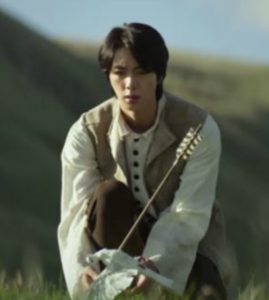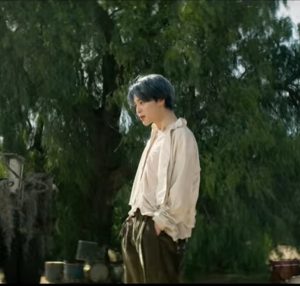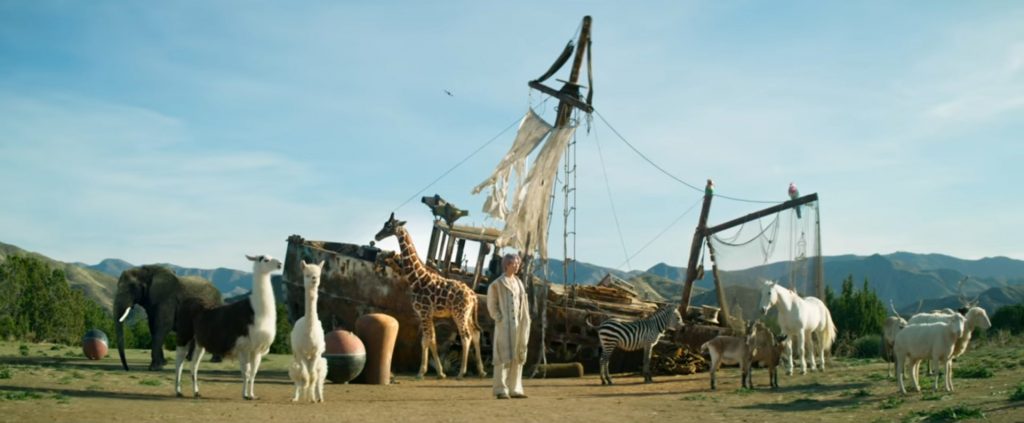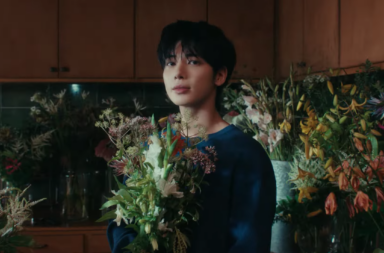
Fans of BTS are familiar with the group’s intricate and well thought out MVs that engage with the conceptual ideas behind each comeback. With the passage of time, these concepts have increasingly moved towards the intellectual and the sophisticated, culminating in their most complex yet, the Map Of The Soul series.
The “ON” Official MV is the second MV to be released this comeback, with the first, the (pretentiously-named) “‘ON’ Kinetic Manifesto Film“, beautifully showcasing BTS’s power as performers. According to Big Hit, the Official MV would,
deliver a symbolic representation of ‘ON’ to highlight a different charm of the multifaceted band.
While it does highlight a “different charm”, “ON” is BTS’s weakest MV yet. At best, it is an enjoyable, cinematic undertaking replete with Biblical references and a new look for the group. However, the stylistic choices are so overt, and the narrative so strange, that the MV barely seems to engage with the conceptual themes underlying the comeback, or even with the song it seeks to promote. Look past the superficial prettiness of what’s onscreen, and one is left confused — why did BTS even release this MV?
To answer the question, it is essential to understand that there are two intertwined themes at play with the latest comeback. First, it is a tribute to the seven-member group’s seven years together since debut. Second, within the Jungian model of the psyche, Map Of The Soul: 7 lies in the realm of the “Ego” and the “Shadow”. Our “Ego” is our sense of identity and existence — this isn’t who we truly are, but who we think we are. The “Persona” is all the traits we want to present to others, an exaggerated, perfected mask; and the “Shadow” is everything we reject about ourselves such as desire, greed, aggression or cowardice. According to philosopher Carl Jung, the “Self” will be complete only when our “Ego” embraces the “Shadow”.
This is seen for instance, in the pre-release MV for Suga‘s solo “Interlude: Shadow“, which perfectly showcases his life as a performer and the shadows that threaten to consume him on his chosen path. In a particularly powerful frame, the shadows chasing Suga freeze when he says “Pause”, and one gets an eerie sense that he does, in fact, have the power to control them — but in his quest for success, he chooses not to. In other words, he embraces the shadows and uses them as a means to propel himself toward greater heights.
Similarly, the artistic film for “Black Swan” with its delicate, ethereal performance and grand setting conveyed a sense of loss, as an artist lost touch with his art (“Shadow”). The more cheery comeback trailer, “Outro: Ego“, reassured us that J-hope remains who he has always been, despite all of BTS’s success (“Ego”). It is a pleasure to see these promotions that feel very true to BTS. In combination with the song and the lyrics, there’s a certain ‘fighting’ spirit, a sense of yearning, of sadness and of hope — an undefinable essence that is at its core, uniquely BTS.
But the Bulletproof Boy Scouts that started out as underdogs fighting for their dreams aren’t underdogs anymore. “ON” takes stock of how far the boys have come since 2013. In doing so, it completely ignores the ideas behind “Ego” and “Shadow”, and stumbles in its attempts to present their new reality.

First, what works: the “different charm” that was promised by the press release. We see the boys take on a medieval European setting. Their outfits, the backdrop, the little girl with V, and the Wall, all bring to mind media like Maze Runner or Attack on Titan. As a fan, it is endearing to see the members in this new form.
Second, it is great fun to try and decipher the narrative. Each member has his own moment — from Jimin standing and dancing in front of a strange, unearthly boy surrounded by drums, trees and an old, rundown car to J-hope simply vibing near a collapsed Jungkook being picked on by crows.
Finally, the production behind the MV is excellent. This comes as no surprise. The MV has been directed and produced by Lumpens, which has produced some of the group’s best MVs yet. We see an expansive landscape in the backdrop of a narrative that is very firmly focused on our seven main characters.

Other than the superficial noted above, the MV mostly leaves one scratching their head. Most jarring is its pace, which clashes openly with that of the song. “ON” is energetic and rousing. It’s meant to get you moving. In contrast, the boys (all except for Jungkook) are in slow, deliberate motion. In juxtaposition with the fast-paced sound, their stillness is disconcerting, and the whole thing feels off. Perhaps the only scene fitting the pace of the music is the dance break.
The narrative presented within the MV also jars with the narrative of BTS that has been presented so far.
Even if I fall, I get back up, scream
Because that’s what we always did
Even if my knees drop to the ground,
unless they are buried under it,
it will be just an ordinary happening
Win no matter what
As mentioned above, Map Of The Soul: 7 is a tribute to BTS’s seven years together. “ON” is an anthemic song about BTS enduring all obstacles and difficulties, meeting their pain head-on, and being strong. Another song that documents their journey is “Sea”, where the members talk of the “desert that became the ocean” though their “blood, sweat and tears”. Back then, the sea represented their new, hard-earned and seemingly fleeting success.

In “ON” however, BTS are positioned as saviors, and parallels are drawn with the story of Noah and the flood. The most obvious imagery here is of RM as Noah, standing by his Ark, now confident of his place and role in the world. He is now a master of the sea (or success). There’s neither floods nor desert, however, but war (around Jin), people who cannot see (the blindfolded girl with V) and those cast out of the society (Jungkook). It doesn’t matter what you need saving from — BTS are there to save you.
The members each have their own moments, some connected to Biblical themes. In Christianity, the Holy Spirit is sometimes symbolized by a dove, such as the one Jin comes across dead in a battlefield. The dove also represents purity and peace. Jin carries home its corpse, which he places in a cage and covers in jute, only for the cage to inexplicably shake. The bird has come alive in his arms. Noah sent the dove to search for dry land, and its return to life within the MV indicates the end of the battle that Jin witnessed. We see it fly away, strong and free, at the end.
With the exception of RM, the savior, the boys’ faces are streaked with dirt. They are peasants, searching for escape and relief. It is unclear what Jungkook is running from, or what battle Jin has seen, but it is clear that freedom can be found only beyond the Wall. RM leads them to the promised land. As they climb to the top of the new world, the words “NO MORE DREAM” change now to “DREAM”.


It is impossible to miss the reference to BTS’s debut where they tackled the pressures of society killing the dreams of the youth. In ending the MV in this manner, BTS are telling us that together with them, fans can dream. Or perhaps that they themselves, given all their success, have learnt to dream.
These dreams did not come easy to the underdogs. In fact, the Jungian ideas behind Map Of The Soul are not necessarily new within the larger BTS-verse. During Hwa Yang Yeon Hwa era (2015-2016), RM once explained during a concert that,
…happiness is not something you have to achieve. You can be happy in the process of achieving something. I know many people are going through tough times right now. But this moment can be the most beautiful moment of our lives. I’m not just saying this…Yes, so if you guys can feel the most beautiful moment in life, I’m sure from this moment till we die, our entire life will be beautiful.
In 2018’s “Epiphany“, Jin sang about loving himself even though he’s not perfect. Embracing dark times, and accepting one’s dark sides has thus been a long-running theme through BTS’s music. Given their rise from nothing, the MV does serve a purpose — to draw the old narrative to a close. In fact, BTS go a step further here, and proclaim themselves as mythical saviors. BTS acknowledge that they are maximizing their potential, and that they can take others along with them.

Not to be underestimated is the medieval European setting of the MV. Whether intentional or not, it is a nod to BTS’s ascent to global popularity. As they move away from Korean variety shows and onto American ones, and as big-name Western producers increasingly take over from Big Hit’s in-house producers in the album credits, there has been a visible trend towards the “Westernization” of BTS. Big Hit has tried hard to stay relatable to its now vast consumer-base. BTS are no longer criticizing Korean society (e.g. “Baepsae” and “Dope“), but looking inwards in on themselves — something all people, young and old, from around the world can relate to.
It is in this context, where BTS profess to be taking stock of their seven years since debut, and where the marketing of the group is faced with a challenge of appealing to an incredibly diverse audience spread out throughout the world, that one can begin to understand the odd Official MV for “ON”. Because otherwise, it is a complete misfit with everything BTS has so far stood for, and even goes against the song “ON” itself. Rather than showcasing BTS’s artistry, the “ON” Official MV captures a local group, and its local parent company, grappling with still-new global super-stardom.
(Christianity, Journal Psyche, Medium, YouTube; Lyrics via doolset lyrics; Images via Big Hit Entertainment)


